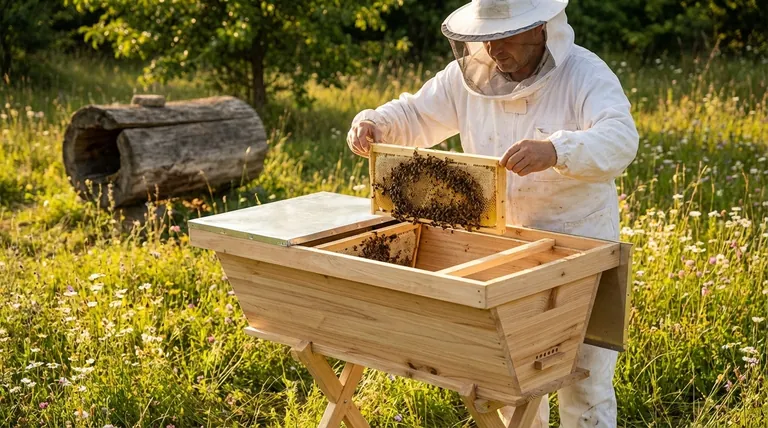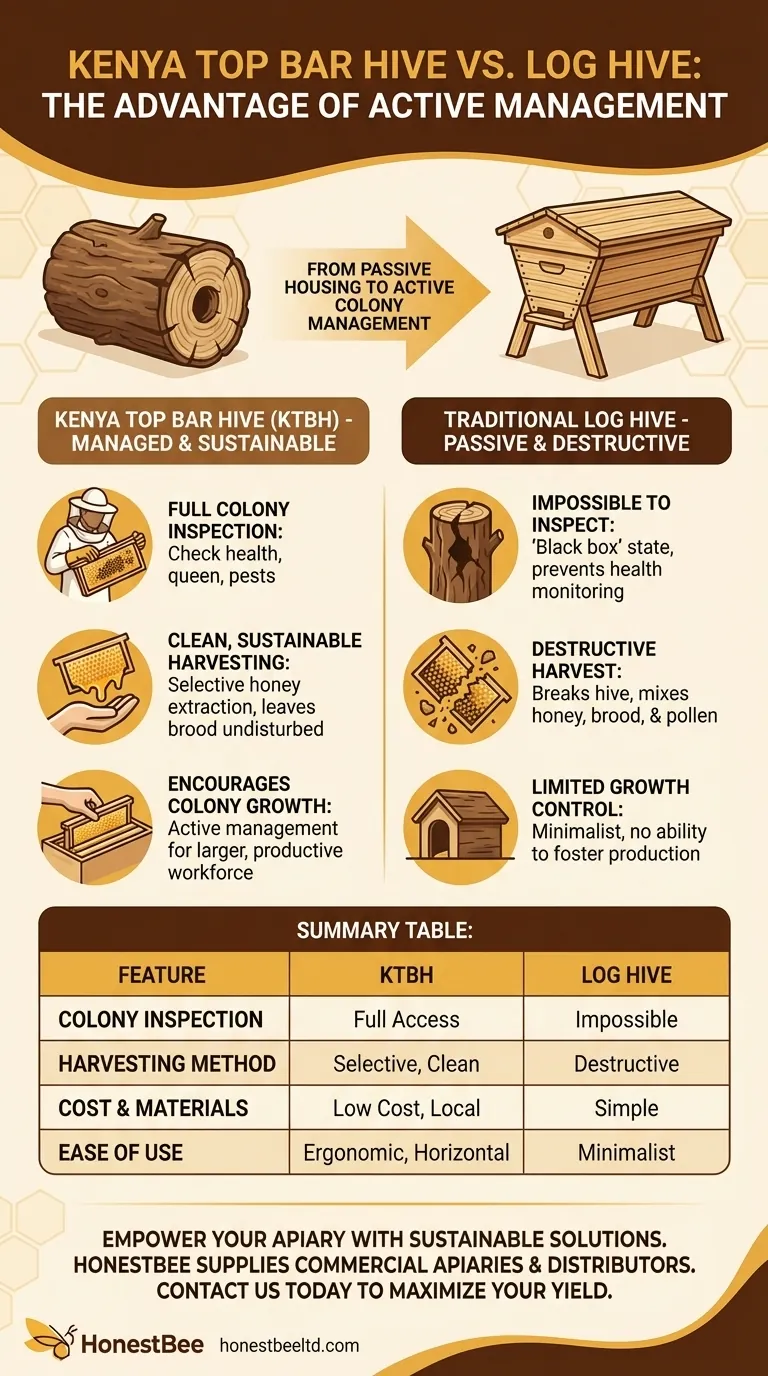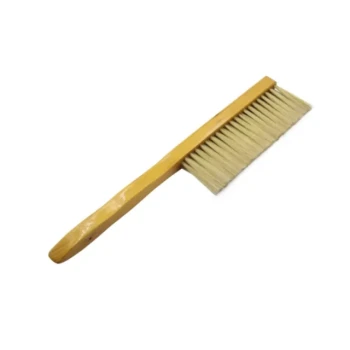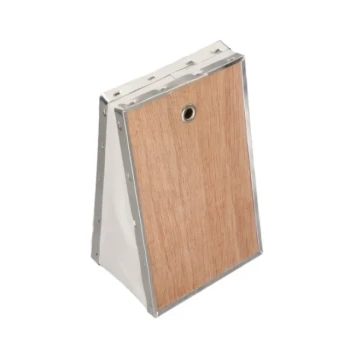In short, the Kenya Top Bar Hive (KTBH) offers significant advantages over a traditional log hive, primarily centered on the ability to actively manage the bee colony. This shift from simply housing bees to managing them allows for easier, more sustainable harvesting, which in turn leads to higher quality honey and healthier bees.
The core difference is a move from a passive, often destructive harvest to an active, sustainable beekeeping practice. The log hive is a simple shelter, while the top bar hive is a tool that empowers the beekeeper to improve colony health and maximize the quality of their honey.

The Shift from Housing Bees to Managing a Colony
The most fundamental advantage of the KTBH is that it transforms beekeeping from a simple waiting game into an active management process. This has profound implications for both the bees and the beekeeper.
Full Colony Inspection and Health Management
A sealed log hive is a black box; you cannot know the state of the colony without breaking it open. In a KTBH, each top bar can be lifted individually to inspect the comb.
This allows a beekeeper to check for a healthy queen, look for signs of disease or pests, and assess the overall strength of the colony. This early-warning system is impossible with a log hive and is critical for preventing colony collapse.
Simplified and Sustainable Harvesting
Harvesting from a log hive is often a destructive process, involving breaking open the hive and cutting out chunks of comb, which mixes honey with brood (bee larvae) and pollen.
The KTBH allows for a selective and clean harvest. The beekeeper can choose only the combs that are full of capped honey, leaving the brood combs undisturbed. This practice is less stressful for the bees and results in much purer, higher-quality honey.
Encouraging Colony Growth and Production
Because you can manage the internal space of a KTBH, you can actively encourage colony growth. By ensuring the queen has ample space to lay eggs, the beekeeper can foster a larger, more productive workforce.
This direct manipulation to "maximise honey production," as noted in the references, is a key reason beekeepers transition from traditional methods.
Practical and Economic Advantages
Beyond bee management, the KTBH presents clear benefits in terms of cost, construction, and ease of use.
Lower Cost and Accessible Materials
A KTBH is significantly cheaper and easier to build than modern frame hives and can be constructed from locally available or scrap lumber.
This low barrier to entry makes it an accessible upgrade for beekeepers who may have limited resources, democratizing a more sustainable form of beekeeping.
Ergonomic and Physical Ease of Use
The KTBH is a horizontal hive, meaning all work is done from the side without lifting heavy boxes full of honey, known as "supers."
This design makes it ideal for beekeepers who may not have the physical strength to manage a vertically stacking hive, making the practice more inclusive.
Understanding the Trade-offs
While the KTBH is a major improvement over a log hive, it's important to understand its limitations.
Increased Management is Required
The greatest advantage—the ability to manage the colony—is also a responsibility. Unlike a "set-and-forget" log hive, a KTBH requires periodic inspections and basic knowledge of beekeeping principles to be successful.
Combs Can Be More Fragile
The combs in a KTBH are supported only by the top bar and are not reinforced by a full frame. They must be handled carefully to prevent the comb from breaking off the bar, which can damage the colony and be a messy cleanup.
Making the Right Choice for Your Goal
Your choice of hive depends entirely on your goals as a beekeeper.
- If your primary focus is a minimal-effort, traditional approach: A log hive requires almost no intervention until a single, often destructive, harvest.
- If your primary focus is sustainable honey production and bee health: The Kenya Top Bar Hive is the superior choice, offering an excellent balance of low cost, ease of management, and high-quality results.
- If your primary focus is maximizing honey quantity for commercial sale: A modern, multi-story Langstroth frame hive is generally the industry standard, though it comes with higher costs and complexity.
Ultimately, adopting the Kenya Top Bar Hive empowers you to become a better steward of your bees, fostering a healthier relationship that benefits both the colony and the keeper.
Summary Table:
| Feature | Kenya Top Bar Hive (KTBH) | Traditional Log Hive |
|---|---|---|
| Colony Inspection | Full access for health checks | Impossible without destruction |
| Harvesting Method | Selective, clean, sustainable | Destructive, mixes honey & brood |
| Cost & Materials | Low cost, locally available lumber | Simple but limited |
| Ease of Use | Horizontal, ergonomic design | Basic, minimal intervention |
| Primary Goal | Sustainable production & bee health | Minimal-effort traditional approach |
Ready to upgrade your apiary with sustainable, manageable hive solutions?
At HONESTBEE, we supply commercial apiaries and beekeeping equipment distributors with the high-quality, wholesale-focused supplies needed to succeed. Whether you're transitioning from log hives or scaling your KTBH operations, we provide the durable equipment and expert support to foster healthier colonies and maximize your honey yield.
Contact HONESTBEE today to discuss how our beekeeping solutions can empower your business.
Visual Guide

Related Products
- Top Bar Beehive for Beekeeping Wholesales Kenya Top Bar Hive
- HONESTBEE Professional Long Handled Hive Tool with Precision Cutting Blade
- Professional Engraved Round Hive Number Tags for Beekeeping
- Long Langstroth Style Horizontal Top Bar Hive for Wholesale
- HONESTBEE Advanced Ergonomic Stainless Steel Hive Tool for Beekeeping
People Also Ask
- What is the quickest method to harvest honey from a top bar hive? A Guide to the Simple 'Cut and Crush' Method
- What are the benefits of a top bar hive? A Natural, Low-Impact Approach to Beekeeping
- What are the advantages of harvesting honey from a top bar hive? Low-Cost, Simple Harvesting for Beekeepers
- Why are hive inspections easier with Top Bar Hives? Achieve a Calmer, Safer Approach to Beekeeping
- What are the labor requirements for a KTBH vs. Langstroth hive? A Guide for Apiary Efficiency



















